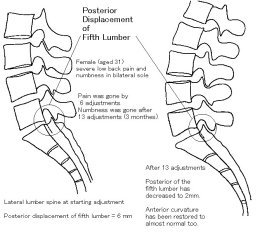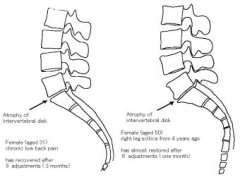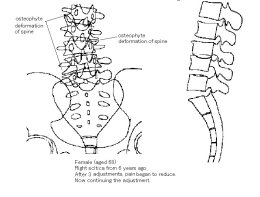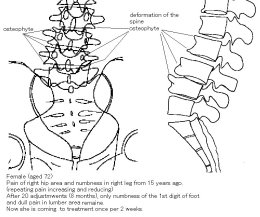Low Back Pain
Last Updated; 1996.10.06
1.Acute Low Back Pain.....Many cases of low back pain
are caused by posterior displacement of a lumbar vertebra.
Following diseases are well known as causes of low back pain.....
Lumbar disk herniation, Spondylolisthesis, Spondylitis deformans, Compression
fracture (Osteoporosis), Lumbar spinal canal stenosis, Spinal osteodesmosis,
Myofascitis, Spina bifida occulta, various kidney diseases (Nephritis, Pielitis,
Renal calculus, Floating kidney, etc), Ureterolithiasis, Cystlithiasis,
Hysteromyoma, Tumor of the spinal cord, metastases of cancer to spinal bone......etc...,etc.....
However, a Japanese orthopedist says that of all of the patients complaining low back pain,
only 20% of patients can be diagnosed with these diseases. And he says that the
remaining 80% can not be diagnosed with a definite disease, so to speak, these are
"lumbago by uncertain factor".
These low back pain due to uncertain factor, is simply called "acute low back
pain or strained back" in the hospital(orthopedics), but I think these are
almost all caused by posterior displacement of a lumbar vertebra.
Therefore, many patients who come to my office for treatment complaining of lumbago say,
"orthopedist said that there is no abnormality in my spine in the result of
my X-ray film diagnosis, but my low back pain is persistant and unchaged."
"There is no spinal abnormality in your X-ray film." means that "bone
pathology such as disk atrophy or vertebral deformity cannot be recognised in
your X-ray film". But a chiropractor will find the existance of the spinal
misalignment on the same X-ray film clearly.
Generally, spinal bones(vertebrae) tend to displace to posterior from their
normal position with joint(facet) structure.
There are cases that a lumbar vertebra displaces in an instant during casual action,
when muscles and ligaments are beginning to weaken by fatigue, insufficient sleep,
and mental stress etc.
For the people over 30 years old, the strength of the muscle tendons and
ligaments that support the backbone(spine), gradually begins to decrease.
Sufficient walking is the easiest exercise to prevent a decline of muscles
and ligaments in your daily life.
However, men/women of today, who are sitting all day long in the office and
commute by a car, have almost no chance to walk, and they are easy victims of
low back pain.
When you bend down, such as to lift a heavy article, to wash your face in the
morning, or to put on the pants, the backward pressure acts to lumbar spine,
therefore a lumbar bone(in many cases, 4th or 5th lumbar vertebra) somtimes
displaces to backward instantaneously because of that action, and the joint fixes in
that condition.
When a spinal joint(facet) fixes, the mobility of the joint is lost and the
person comes to feel pain at the tendons and ligaments surrounding the joint
and joint cartilage etc.. When a displacement is caused sharply, an acute
inflammation of soft tissues of joint surroundings will occur, and will cause
pain also.
This is the condition which is so-called "acute low back pain" or "strained back."
In the first time occurrence of an acute lumbago, posterior
displacement of lumbar vertebra may be about 1-2 mm probably, but even such
small displacement would sometimes be enough to prevent a person from standing up entirely.
[ As for detailed explanation about Posterior Displacement,
click here. ]

Next, how does a chiropractor treat posterior displacement? Even if a lumbar
vertebra has posterior displacement, it is not necessarily adjusted.
Having been explained in "Philosophy of Chiropractic", chiropractor will adjust
the vertebra that was determined as a major subluxation. And major subluxation
will not always be identified as the lumbar vertebra that is causing pain.
Even if the same vertebra is in the same malposition in two patients, the major
subluxation that has decreased healing power will be different depending on the
patient, and also it may be the pelvis or cervical spine, or the lumbar
vertebra itself that is causing pain.
If the chiropractor can improve skillfully the INNATE INTELLIGENCE that patient has
potentially, the vertebral displacement will be corrected by his/her own
healing power.
[ When you have sudden low back pain unfortunately........]
[ Self treatment & Advice ]
- 1. If you can not stand up with severe pain......
- It is best to rest in bed.
Lying on either side will be better than on your back or on your stomach.
Find least painfull direction, and bending your hip joints and knee
joints slightly, rest in bed.
Lying on your back or on your stomach will load your weight on the
displaced lumbar vertebra, and will increase pain.
During rest, cool the painful lumbar area for 10 minutes with ice or other
cooling apparatus. After one hour interval, cool the same area for 10
minutes. Repeat this procedure 4-5 times in a day.
- 2. If you are somehow able to get up and able to do housework or
job .....
- a. Make an effort as much as possible to maintain the following posture.
- Sticking out your abdomen foward and lifting up your buttocks.
This posture is under condition where the lumbar spine is forming
the anterior curvature(lordosis). Furthermore, you should make an effort to
lay stress on the back muscles so as to maintain the anterior curvature
of waist (supporting the displaced lumbar vertebra with the back muscles).
I have written previously that a lumbar vertebra could displace to
posterior in most cases. This posture mentioned above does not
force the lumbar spine to the posterior.
Conversely, if you slack the back muscles and round lumbar spine to
backward, muscle support will be lost and lumbar vertebrae will be
stressed backward along the joint face by body weight.
By the way, I think that this posture is the sole method for adapting the
backbone to gravity with a pair of legs, and will be the basic
posture for all sports and military arts.
If you have custom of rounding your backbone, your back muscles will
weaken and your spine will be fixed up with aging. In due time, you
will not be able to erect up your backbone. This is called "senile
kyphosis". A compression fracture of the spinal column by osteoporosis
will facilitate this "senile kyphosis".
- b. Don't stay still long time, whether you are sitting or standing.
- Because a spinal joint is fixed, staying still a long time will cause
the spinal fixation again. Walk around as much as possible maintaining
the posture mentioned above.
Time length of the walking at a time will be enough to 20-30 minutes.
Yet, suspend the walking if pain becomes awful by walking.
Walk! Walk! Walking is the most simple, inexpensive healthful exercise.
If you have any acquaintances or friends who suffer from low back pain, tell
them above points by some means or other.
2.Chronic Low Back Pain.....Don't give up even if an orthopedist says
to you, "your problem is caused by senility"
When severe low back pain is caused, any kind of treatment such as traction,
low frequency electrization, heat pack, acupuncture and moxibustion, or even
merely resting in the bed (a vertebral displacement is remained), if that
treatment could recover the movement of the fixed vertebral joint to some
extent, pain will be gone for the present.
In this case, that vertebral joint remaining displacement has become weak,
and next physical stress will worsen the displacement again. In this way,
this vertebral joint will become weaker and weaker, causing low back pain each time.
Repeating displacement many times, when 5-10 years pass from first
displacement, pathological changes of the bone gradually occur as well as
the displacement worsen. For example, atrophy of the disk(narrowing between
vertebral space), formation of the osteophyte(deformation of the spinal bone)
will occur.
Following is my clinical experience.
When a posterior displacement of a lumbar vertebra becomes 5mm or more,
a nerve root begins to be compressed in a intervertebral foramen(a passage of
the nerve to the leg), consequently sciatica will occur in the leg. Needless
to say there are differences among individuals. And concuring a problem of the
disk such as disk herniation, sciatica might occur. Even this case,
chiropractic adjustment will help with the exception of a few cases.
In the chronic cases, many Japanese orthopedists will say to the patients as
the result of X-ray diagnosis "your intervertebral space is narrow(atorophy of
the intervertebral disk) and spinal senility is now advancing." or "your spinal
bone is developing deformation(osteophyte formation), this is due to the
senility." Then patients and doctors accept the word "senility" and will give
up recovery from the present condition.
But, never give up!
Although intervertebral disk has become narrow or deformation of spinal bone is
developing, if we can restore the displacement to a small extent and if only
we can improve the mobility of the spinal joints, patients' symptoms will be
restored even to the extent that there is no obstruction in a daily life.
In my office, I have experienced many cases like that.
Now, I will explain the pathological changes such as decreasing of the
intervertebral disk thickness(atorophy of the disk) and deformation of the
spinal bone(osteophyte) from the standpoint of chiropractic. These pathological
changes are never symptoms of senility, but are the result of simple
physiological phenomena of the human body.
[ Atrophy of the disk (narrowing the intervertebral space) ]
The intervertebral disk contains water and it amounts to 85% of the disk weight,
and this is a jelly-like substance. This has structure that surrounding
fibrous ring wrap the nucleus pulposus(functioning as a ball bearing).
Because blood vessels to the intervertebral disks disappear after adolescence,
taking in nutrition or discharging waste matter are done through the
means that body fluid of the surrounding disk goes in and out to an
intervertebral disk. It is the normal joint movement of the vertebra that is
propeling the incoming and outgoing of the body fluid from disks(metabolism).
However, when a vertebra displaces, normal mobility of the joint is lost and
the pump action will disappear or decline. Therefore body fluid cannot be
taken by an intervertebral disk, resulting in moisture being lost gradually
from the disk. Finally the disk will lose its thickness.

[ Deformation of the spinal bone(Osteophyte) ]
Meanwhile, if the displacement of vertebrae remains, the normal
mobility of the joint has been lost, and an excess physical stress will attack
the joint all the time.
Then the physiological function of the body will take the way to stand up
against the excess stress with improving physical strength of that joint.
In order to increase the joint strength, body can utilize calcuim, therefore
this element will be accumulated to the displaced vertebra.


The above description is the interpretation of the disk atrophy and spinal
bone deformation from the standpoint of chiropractic. Also these pathological
changes will come to occur in the cases that the entire body has fallen into
lack of exercise and the spinal mobility has been lost. This is not caused by
aging but is caused by lack of the spinal mobility.
We can explain reasonably from this viewpoint that an aged person has
some youthful areas in their body and that young or middle aged person
has some areas developing narrowing of disk or spinal deformation.
You, now reading this page, aren't you making your waist round back?
Keep in your mind so that you should sit with your waist arching anterior.
And, enjoy youthful fine life!

back to "Chiropractic in Japan"
Copyright 1996-; All rights reserved."Chiropractic in Japan" Maeda Shigeru
|



